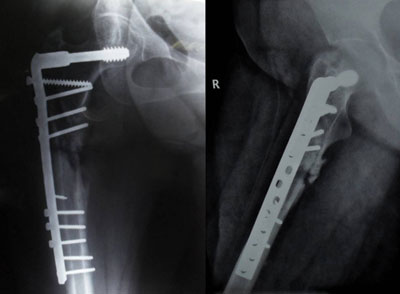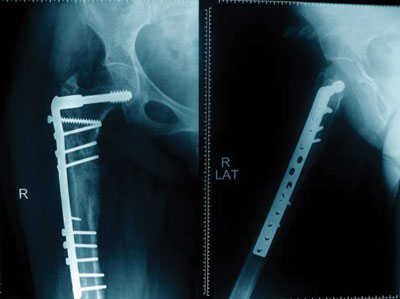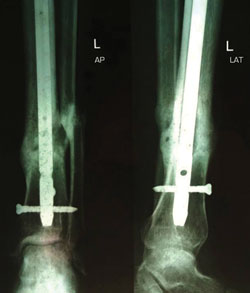Platelet concentrate united most long bone fractures at 12 weeks, study finds
Researchers saw callus formation 8 weeks after autologous platelet concentrate use.
SAN FRANCISCO — A platelet concentrate injected into nonunited long bone fractures increased union rates, according to a presenter at the American Academy of Orthopaedic Surgeons 2012 Annual Meeting.
“Platelet injection in nonunited fractures can save an extra surgery and shorten the union time,” Vijay Kumar, MS, co-author of the study, told Orthopedics Today.
Rajesh Malhotra, MS, presented the findings at the meeting.
“Since the initial healing immediately after the fracture is mediated by platelets, we wanted to know whether a strong dose of platelets can kick start healing again in patients where it has stopped prematurely (before healing),” Malhotra told Orthopedics Today.
|
Images: Kumar V; Malhotra R |
Kumar and colleagues investigated the effectiveness of platelet concentrate for the treatment of long bone fractures and nonunions, and included 60 patients in their study (36 men and 24 women) with radiological signs of nonunion. All patients had stable internal fixation or stable reductions aided by plaster immobilization. They included patients with more than 90% bone contact.
“Nonunion was defined as a fracture of duration more than 6 months after injury or time from last fracture site operation, which had not shown progressive evidence of healing process throughout the past 4 months,” Kumar said.
Among the patients the researchers excluded were those with gap nonunions, skin infections, pseudoarthrosis, thrombocytopenia, hypofibrogenemia and patients who were on aspirin or another drug that could affect platelet function.
|
|
The investigators injected patients with 20 mL to 30 mL autologous platelet concentrate made from platelets that patients donated the day surgery. Making the concentrate involved “a series of centrifugation and separation cycles to concentrate platelets without inducing their premature activation,” according to Kumar, who said the team ensured a platelet count of 200,000/uL for all the platelet concentrations used and that the concentrates were leukoreduced.
Time to union
The researchers observed callus formation in 55 of the patients after 8 weeks. Bridging of trabeculae occurred at 12 weeks in 40 patients. The other 15 patients’ long bone fractures united at 24 weeks. Investigators used revised fixation with cancellous iliac bone grafting to treat the five fractures that did not unite, which resulted in union 3 months later.
The average time from injury to platelet injection was 9.1 months after diagnosis of nonunion, Kumar said. However, patients with a post-injection union received platelet injections within 2 months to 4 months after a nonunion diagnosis. The five patients who failed to show union following intervention had received platelet injections 12 months or more following their diagnosis.
“Although we were expecting platelets to help in achieving union, the fact that we could achieve union in 55 out of 60 cases was surprising,” Kumar said.
|
|
|
In the future
Kumar, Malhotra and colleagues plan to perform a similar randomized, controlled study. They cited using centrifugation for concentrating platelets as a limitation in this study.
“It may lead to the fragmentation of the platelets and early release of growth factors and cytokines, reducing bioactivity,” Kumar said. “Ultra-filtration to prepare [platelet-rich plasma] PRP may be a more scientific and efficient method.” – by Renee Blisard
Reference:For more information:
- Malhotra R, Kumar V, Trikha A. Platelet concentrate in treatment of nonunion of long bones. Paper #27. Presented at the American Academy of Orthopaedic Surgeons 2012 Annual Meeting. Feb. 7-11. San Francisco.
- Vijay Kumar, MS, can be reached at email: vijayaiims@yahoo.com.
- Rajesh Malhotra, MS, can be reached at email: rmalhotra62@gmail.com.
- Kumar and Malhotra can be reached at Department of Orthopaedics, All India Institute of Medical Sciences, Ansari Nagar, AIIMS, New Delhi, 110029, India; + 911-11-26588500.
- Disclosure: Kumar and Malhotra received study funding from the Indian Council of Medical Research.





